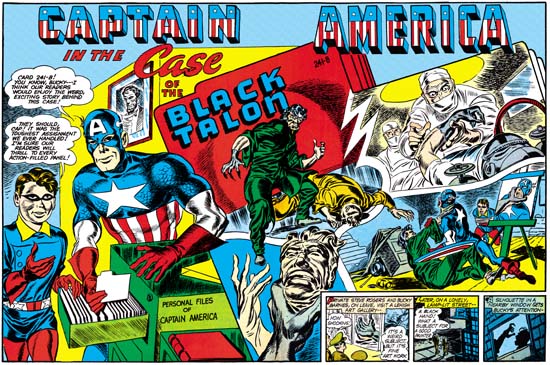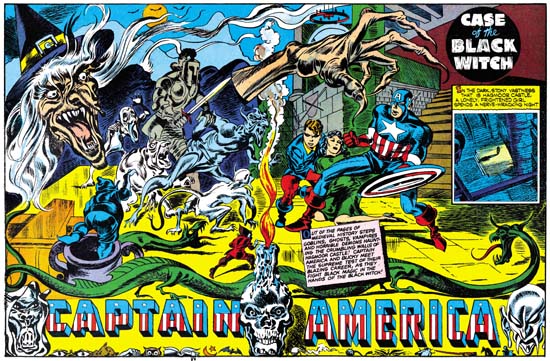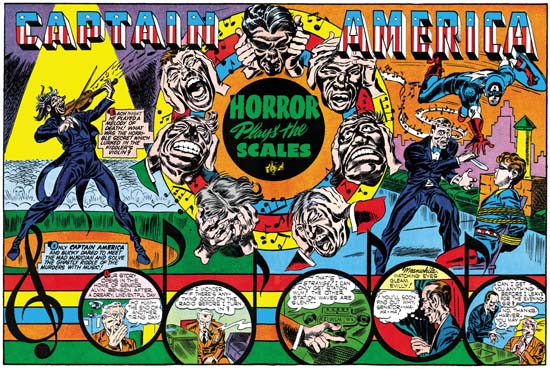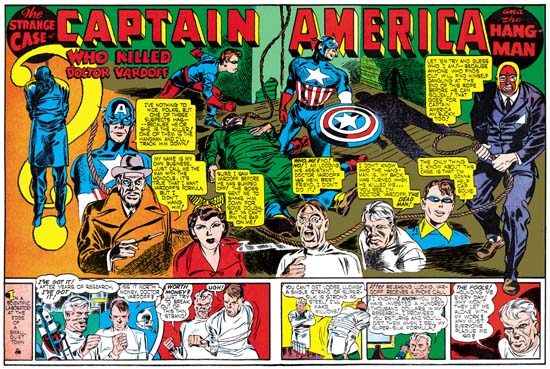
Boy Commandos #2 (Spring 1943) “The Knights Wore Khaki”
Enlarged view
When it comes to double page splashes, there are great differences between Simon and Kirby’s DC years compared to their Timely period. Once the wide splash appeared in Captain America #6 it became a standard part of that title. At DC despite the fact that S&K largely worked on three different features (Sandman, the Newsboy Legion, and the Boy Commandos) there is only a single example of a double page splash. Much of this can be explained by the fact that the wide splash required the use of the center page if publication problems were to be avoided. Planning for this was not an issue with Captain America because Joe Simon was the art editor and with Jack Kirby he produced the entire Cap comic. At DC S&K provided work for other editors and most of their work were for comic titles that included other features (Adventure, Star Spangled and Detective Comics). Under these conditions it was probably difficult for Joe and Jack to plan for the use of the center fold. But this does not explain the lack of wide splashes in Boy Commandos Comics. Even if they were not the editors, Joe and Jack should have been able to have more control in the Boy Commandos Comic, at least initially.
There is a also big design difference between the Cap wide splashes and the single DC example. At a glance at “The Knights Wore Khaki” splash we might feel we have found the same sort of three compartment design that was so common in Captain America. Common to both is are enactment and cast of characters sections. Missing from Boy Commandos is the one constant of Cap wide splashes, the start of the story. Instead we find a new section which brings an importance to the introduction text. But the three sections are not integrated like they were in Cap. Yes there are some visual linkages. The Boy Commandos title goes from the introduction text section into the enactment part. Also in the introduction text section there is a horn that extends into the enactment. The left portion of the host of characters has a scroll below which can be seen part of the enactment. Also all three sections contain middle age thematic material that link them together. But despite all that the compartments really look they are laid out in three distinct sections. This is nothing like the carefully integrated designs of wide splashes found in Captain America.
There really is not a lot to say about the cast of characters section. It is basically a row of simple panels with head shots. Do not get me wrong, Kirby as done his usually marvelous depictions. The glare given by Captain Von Shlepp just hits you in your guts, you can just tell he is not going to be a pleasant person. All the other head shots provide distinctly personalities. But as for the design, there really is nothing new here and it shares a problem that the story start sometimes had in Captain America. Laying out of row of panels tends to visually separate those panels from the rest of the splash and defeats any integration with the reset of the page.
I have more positive feelings about the introduction text compartment. Sure, like the host of characters, it does stand out as a separate identity. But that does have the benefit of providing less distractions to the text. I also love how the drape hanging from the horn is used to frame the text. It was also a good for the design that the start of the Boy Commando title starts in this section since that part takes up so much room. This part may not be integrated with the rest of the page, but within this section we are given a rather nice design.
In the enactment part that we see the greatest change from previous double page splashes. Most of the Cap splash enactments were limited to three or four characters; Cap, Bucky, the foe and/or the victim. But the Boy Commandos have five heroes so the enactment has to be more complicated. Joe Simon once remarked to me how difficult it was to draw a story with such a crew and how well Jack managed it. You can really appreciate this when examining Boy Commando stories not done by S&K. Invariably these stories center on Brooklyn and to a lesser extent Rip Carter. But all the rest of the cast pretty much get shoved to the insignificant parts. But the easy path was not Jack’s way, all the heroes play important parts, and that is true in this splash also.
There was one splash (Captain America #8 “Case of the Black Witch”) were Simon and Kirby had a large cast of characters in the enactment. S&K used a candle flame and smoke to divide the ensemble into to half and bring some order to the splash. The Sleeping Beauty serves a similar purpose in this splash. She provides a center focus of calm that visually matches her sleep. But unlike the candle in Cap #8, Sleeping Beauty does not bring order to the rest of the splash. Instead she is eye in the center of a hurricane. She is surrounded by chaos on steroids. An all over composition as if Jackson Pollack had become a comic book artist. No part more significant then others. The fight is not something that can be comprehended at a glance. It takes extended viewing to understand the action. For example in the upper right at first it looks like a Nazi’s shield has been shattered by a blow from a sword. But a closer look reveals that the damage is actually being done by the joisting spear from the soldier on the horse. It may take time to understand in some cases what head belongs to what body. But time spent on viewing this Kirby masterpiece is time well spent. This sort of exciting chaos shows up in other (single) splash pages at this time and we will see further wide splash examples in the future.

Adventure #75 (June 1942) “The Villain From Valhalla” by Jack Kirby
I will not attempt a detailed description of this scene, that would take way to long and would not be anywhere near the fun of doing your own examination. But I would like to point out relatively low key way that S&K handles the heroes. Brooklyn stands out in the front left because he is not wearing a soldier’s uniform like all the rest. But it is easy to miss Jan on the left because he is turning away from the viewer. Similarly that is Rip Carter on the horse at the top, but we can only tell by his action since his face is hidden. On the upper right we are presented a the back view of Andre. We do get a good view of Alfy in the front right but even he can be missed among all the fighting faces and bodies.
The other thing I want to point out is the Nazi officer on the left. The officer turns towards the viewer and brings up his hand to enforce his yell. One might think that he is yelling at the viewer, but since his is the enemy that does not make any sense. Instead he must be yelling for unseen reinforcements. This is a motif that Jack would use from time to time. We already saw it with a Japanese soldier on the cover the Champ #23 (October 1942). In later years Kirby would modify it and use it with the hero that really is (loudly) addressing the viewer (Captain America #197, May 1976).
I generally concentrate on the visual art of Simon and Kirby. But of course comics are pictures and words. Check out the writing on this splash. It is short but effectively contributes its part to making this a great piece of comic book art. I particularly like how the text in the cast of characters has a staccato rhythm but reads like a long sentence. I have heard stories of DC writers delivering Simon and Kirby with scripts only to find as they left the building the scripts sailing out of the studio windows. That story is actually so great that it makes me doubt its veracity. But writing like that shown on this splash is so excellent, so similar to the writing in Simon and Kirby done after the war, and so dissimilar to DC writing at the time. If Joe and Jack used the scripts provided by DC it was as a template to be modified at will in order to achieve S&K’s unique quality.
This Boy Commandos work makes me really regret that Simon and Kirby did not do other wide splashes during there DC years. But we will see further exciting examples of this demanding pectoral device when Joe and Jack set up their own shop after the war.






